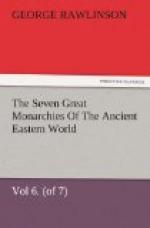We may presume that Tiridates, when he built this remarkable city, intended to make it the seat of government. Hecatompylos, as a Greek town, had the same disadvantages, which were considered in later times to render Seleucia unfit for the residence of the Parthian Court and monarch. Dara, like Ctesiphon, was to be wholly Parthian. Its strong situation would render it easy of defence; its vicinity to forests abounding in game would give it special charms in the eyes of persons so much devoted, as the Parthian princes were, to the chase. But the intention of Tiridates, if we have truly defined it, failed of taking permanent effect. He may himself have fixed his abode at Dara, but his successors did not inherit his predilections; and Hecatompylos remained, after his reign, as before it, the head-quarters of the government, and the recognized metropolis of Parthia Proper.
After passing in peace and prosperity the last twenty years of his reign, Tiridates died in a good old age, leaving his crown to a son, whose special name is a little uncertain, but who is called by most moderns Artabanus I.
Artabanus, having ascended the Parthian throne about B.C. 214, and being anxious to distinguish himself, took advantage of the war raging between Antiochus III., the second son of Seleucus Callinicus, and Achseus, one of his rebel satraps, to advance into Media, and to add to his dominions the entire tract between Hyrcania and the Zagros mountains. Of the manner in which he effected his conquests we have no account; but they seem to have been the fruit of a single campaign, which must have been conducted with great vigor and military skill. The Parthian prince appears to have occupied Ecbatana, the ancient capital of the Median Empire, and to have thence threatened the Mesopotamian countries. Upon receiving intelligence of his invasion, Antiochus levied a vast army, and set out towards the East, with a determination to subjugate all the revolted provinces, and to recover the limits of the old Empire of Nicator. Passing the Zagros chain, probably by way of Behistun and Kermanshaw, he easily retook Ecbatana, which was an open town, and undefended by the Parthians, and proceeded to prepare for a further advance eastward. The route from Ecbatana to the Caspian Gates crosses, of necessity, unless a considerable circuit be taken, some large tracts of barren ground, inlets or bays of the Great Salt Desert of Iran. Artabanus cherished the hope that here the difficulties of the way would effectually bar his enemy’s progress, more especially as his troops were so numerous, and as water was scanty throughout the whole region. The streams which flow from Zagros towards the East are few and scanty; they mostly fail in summer, which, even in Asia, is the campaigning season; and those who cross the desert at this time must depend on the wells wherewith the more western part of the region is supplied by means of kanats or underground




